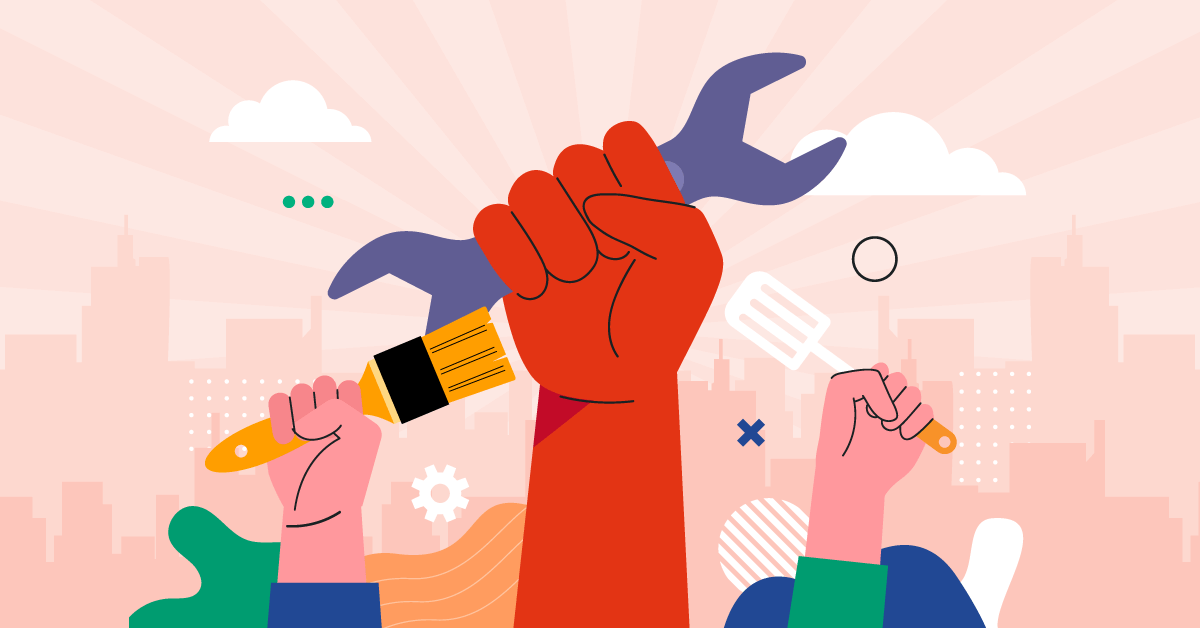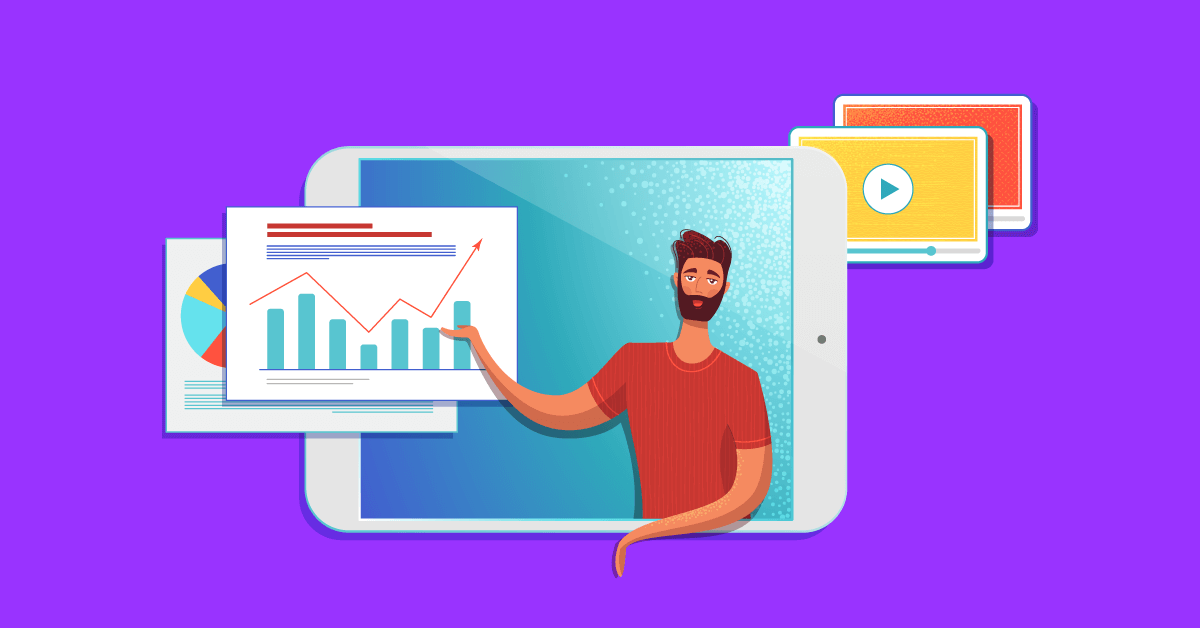But the landscape of the modern workplace has changed. The traditional office set-up is dying out. Online tools have taken center stage. And remote work and asynchronous communication are the norm.
As the dynamics of work continue to shift, so too must the approach to learning.
So the question is: Does experiential learning still hold its ground?
Can this time-honored method thrive where physical presence is replaced by virtual collaboration?
In this article, we ask: Is there still a place for experiential learning in the modern (virtual) workplace? And, if so, how can it be harnessed to empower digitally driven employees?
Digging into the experiential learning cycle
Experiential learning focuses on learning through direct experiences and reflection. What does this look like? In the workplace, employees actively engage with real-world situations, analyze their experiences, and apply insights to improve their skills and understanding.
Let’s see this with an example. In a marketing agency, an employee is tasked with creating a social media campaign for a client. Instead of receiving instructions, they actively engage in the process. Meaning, they research the client’s industry, develop content, run the campaign, and evaluate its performance. This hands-on experience allows the employee to discover valuable insights about audience engagement and content strategy.
A popular framework for experiential learning is Kolb’s learning theory. It consists of four stages:
- Concrete experience (CE): Encountering a new experience
- Reflective observation (RO): Reflecting on the experience
- Abstract conceptualization (AC): Creating abstract concepts and theories
- Active experimentation (AE): Applying learned knowledge to new situations
This learning theory is crucial for achieving successful experiential learning at work due to its valuable benefits. In detail:
- Adaptive learning: The flexibility of Kolb’s model aligns with the dynamic nature of modern workplaces
- Problem-solving: By analyzing issues, learners find solutions to practical issues
- Self-awareness: Reflective observation boosts emotional intelligence and communication
- Remote work: Using digital tools, Kolb’s framework can be applied to remote and asynchronous work environments
- Lifelong learning: This learning theory helps promote a continuous learning mindset that empowers professional development
The challenges of Kolb’s learning theory in modern workplaces
Implementing Kolb’s learning theory in modern workplaces comes with several challenges. But by knowing what to expect, organizations can successfully adapt the framework. And reap the benefits it offers.
Here’s what needs careful consideration:
Diverse learning styles
Kolb’s theory assumes a linear progression through the four stages. But people’s learning preferences differ. Some will gravitate towards certain stages, while others may find them less intuitive. As a result, the application of Kolb’s theory across a diverse workforce can become complicated.
Tip: Tailor experiential learning opportunities to cater to different learning styles. Offer a mix of activities like simulations or quizzes, and provide additional resources.
Remote work and asynchronicity
Employees in remote work settings may not always have timely access to mentors or colleagues to reflect and discuss. Asynchronous communication disrupts the seamless flow of Kolb’s learning cycle, and, more particularly, the immediate feedback loop.
Tip: Set up clear communication channels. Allocate designated time for reflection. And create virtual spaces for collaborative learning. At the same time, encourage employees to use collaboration tools effectively.
Time constraints
The modern workplace is fast-paced. Deadlines and daily tasks can interfere with the experiential learning cycle. And force employees to skip the reflective and abstract conceptualization stages.
Tip: Bring flexibility to the process. Invest in an LMS that delivers self-paced learning. And provide soft skills training that supports this self-directed approach. For example, time management, dealing with distractions, and coping with anxiety.
Resistance to change
Sometimes employees (or organizations) can be reluctant to adopt new learning models. This resistance to change can hinder the full and effective integration of experiential learning in the workplace.
Tip: Provide training on the importance of changing habits. And offer support to employees and leadership teams to help them adapt.
Resource availability
A 360 approach to experiential learning can require investment in additional resources. For example, training programs or coaching/mentoring initiatives. As a result, organizations with limited resources may struggle to commit fully.
Tip: Consider investing in tools and platforms that facilitate experiential learning. Opt for solutions that deliver training content in various formats and channels.
Measurement and assessment
The impact of Kolb’s learning theory on employee performance and skill development can be hard to measure. This is because traditional assessment methods might not fully capture the holistic nature of experiential learning.
Tip: Develop clear evaluation criteria to measure the impact of Kolb’s learning theory on performance and skill development. A mix of quantitative and qualitative assessments is the best way to achieve that.
Technology adaptation
Not all employees are comfortable with digital tools, AI, or simulations. But without them, experiential learning won’t work in remote or online work environments.
Tip: Offer extra digital tools training to employees who need it. And underpin this with ongoing coaching and mentoring sessions.

Applying experiential learning in a remote work setting: 5 simple steps
As mentioned, experiential learning can work well in a remote work setting. But it takes a considered approach. Below are five steps you can follow to put Kolb’s theory into practice.
Step 1: Identify learning objectives
Challenge: In remote workplace environments, it can be difficult to align learning objectives with daily tasks and goals.
Solution: Clearly define the specific learning objectives that are relevant to employees’ roles and the organization’s needs. Make sure these objectives are practical and achievable in a remote setting.
Step 2: Concrete experience (CE)
Challenge: Some remote employees might not have access to the hands-on experiences available in traditional workplaces.
Solution: Actively encourage employees to participate in real-world activities, even remotely. Assign projects, tasks, or simulations that mimic real-life scenarios.
Step 3: Reflective observation (RO)
Challenge: Self-reflection can be an isolating experience for employees working remotely.
Solution: Schedule regular check-ins and virtual meetings where people can discuss their experiences, challenges, and insights. Also, encourage asynchronous peer discussion through discussion boards on your employee training software.
Step 4: Abstract conceptualization (AC)
Challenge: Remote workers may struggle to connect abstract concepts with personal experiences.
Solution: Provide resources like webinars, online training courses, or virtual workshops through your LMS. And use them to help employees link their experiences to broader theories and concepts. Discussion boards are also helpful for sharing insights.
Step 5: Active experimentation (AE)
Challenge: Employees might struggle to apply learned knowledge to new situations when working remotely.
Solution: Encourage your teams to apply their insights to their day-to-day practices. Offer opportunities for them to experiment with new approaches and solutions. Then provide feedback channels for continuous improvement.
When not to apply experiential learning in the workplace
Experiential learning is a powerful and versatile educational approach. But it’s not the only approach. And sometimes it’s better to blend elements of the framework with other methods.
Let’s see in detail:
Urgent training needs
The experiential learning process can be time-consuming. If training’s urgent, start with solutions that are quicker to roll out and deliver results.
How to blend: Establish the necessary foundational knowledge using online tutorials, modules, and workshops. With a basic understanding in place, transition to experiential learning methods to reinforce and apply that knowledge in practical settings.
Complex theoretical concepts
When dealing with practical, real-world scenarios, experiential learning is extremely effective. But what about abstract or theoretical subjects like math?
How to blend: Start with traditional classroom instruction or ILT to make sure learners grasp the theory. Then follow up with experiential learning activities which allow learners to put theory into practice.
Large-scale training programs
Providing hands-on experiences to large numbers of learners isn’t always practical.
How to blend: Use online training or webinars delivered through an LMS to deliver key content. Then, plan smaller, more focused experiential learning sessions to encourage meaningful interactions and hands-on experiences.
Lack of resources
Sometimes experiential learning in remote settings requires access to specific tools and technologies that are costly or hard to source.
How to blend: Virtual simulations or online workshops (delivered through an LMS) are ideal when resources are limited.
Limited employee engagement
If employees are disengaged or resistant to experiential learning, success will be limited. t
How to blend: Address motivational issues by gradually introducing experiential learning elements into the training program. Begin with small, engaging activities. Then slowly increase the complexity of experiential exercises as participants become more invested.
Experiential learning and the future of work
As we journey into the future, experiential learning has the potential to flourish. Yes, it needs to adapt to suit an increasingly diverse and dispersed landscape. Which means combining in-person and digital interactions to offer personalized learning experiences. And using immersive technologies and data-driven insights to boost engagement.
But with the right blend of strategies, it’s well-placed to do that. The ROI? Effective skills development and professional growth. And a dynamic, flexible and sustainable model for the workplace of tomorrow, as well as today.



